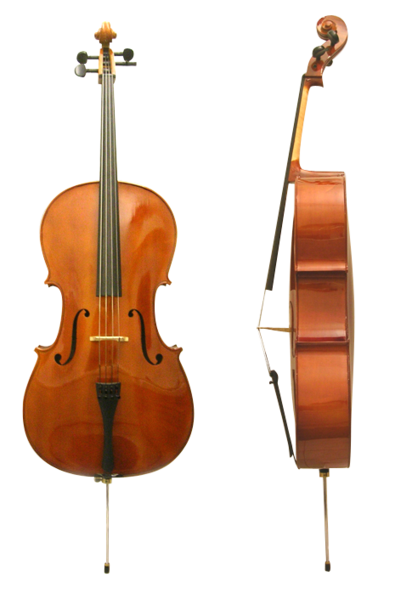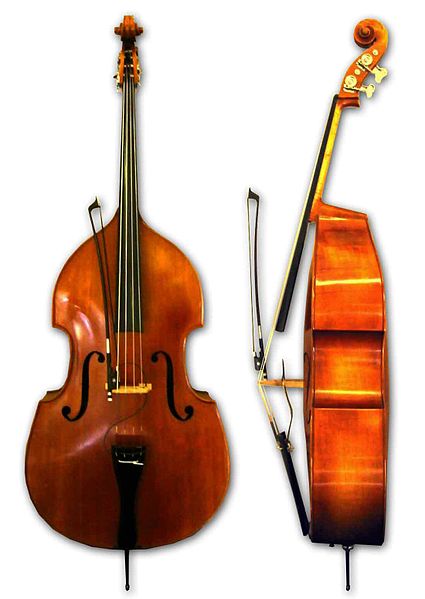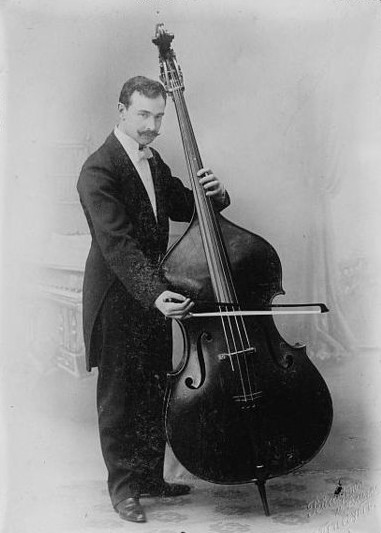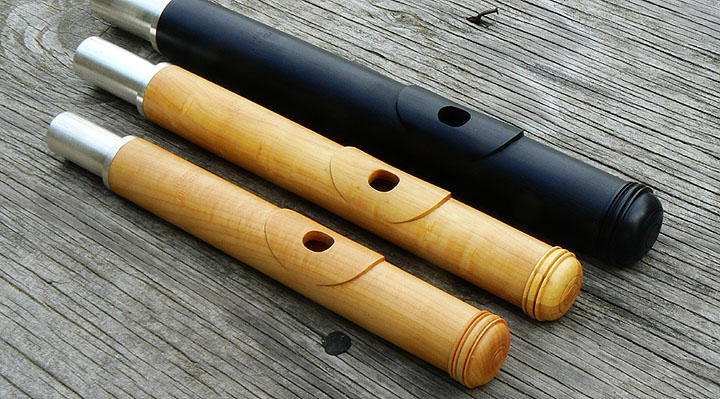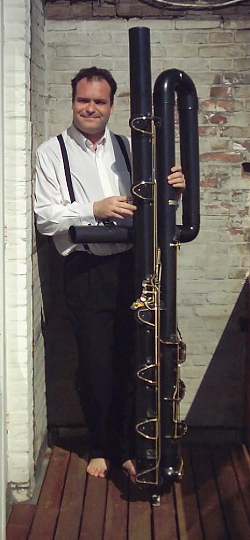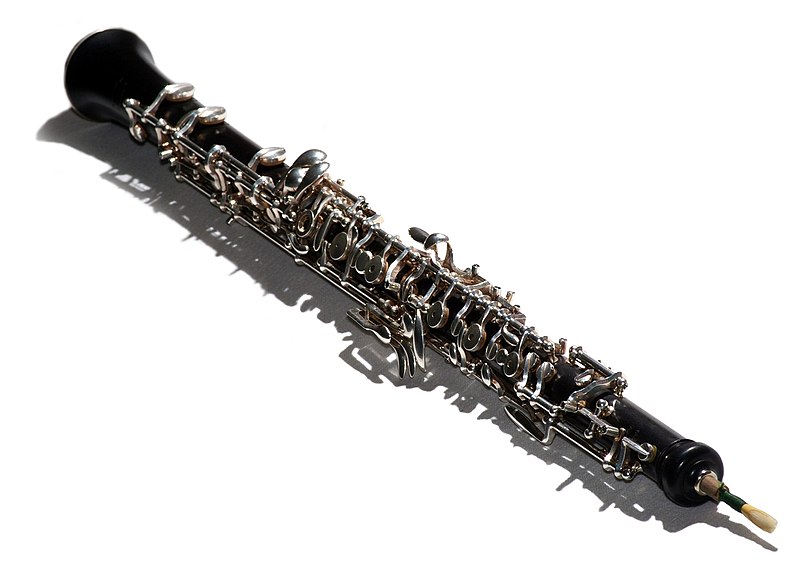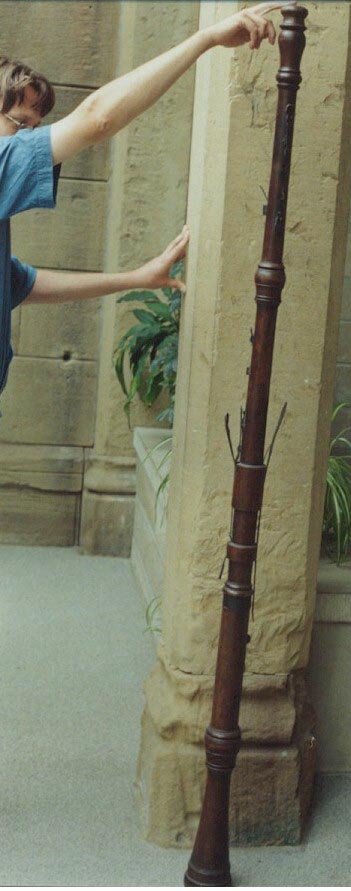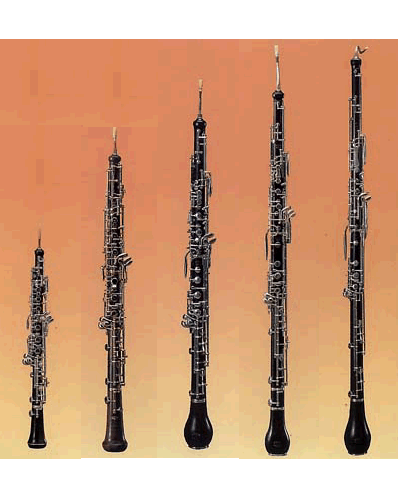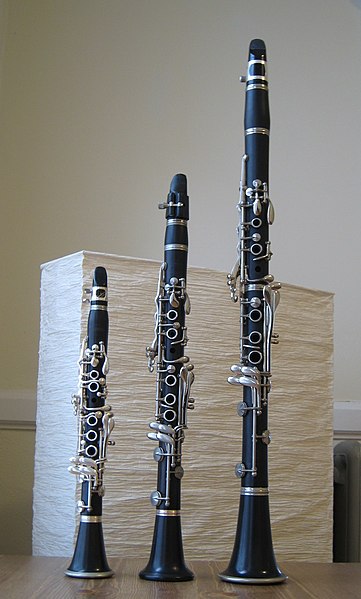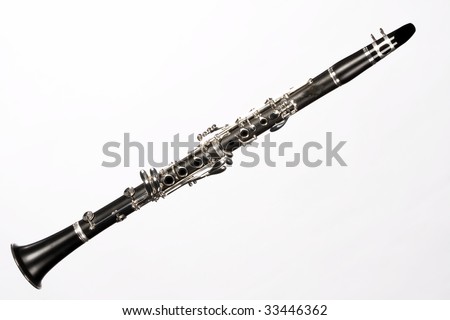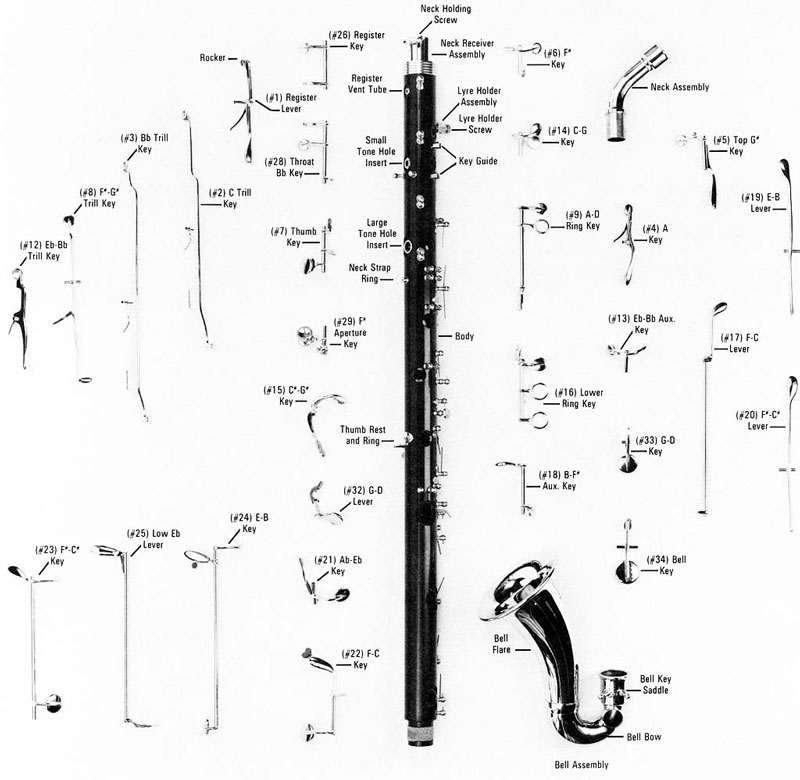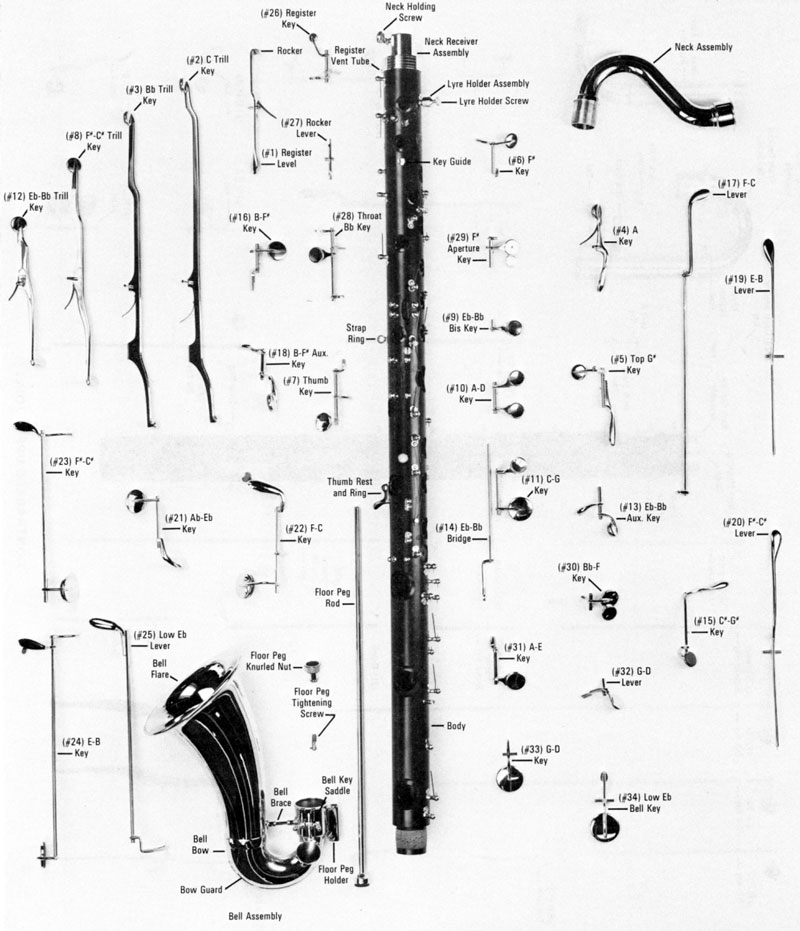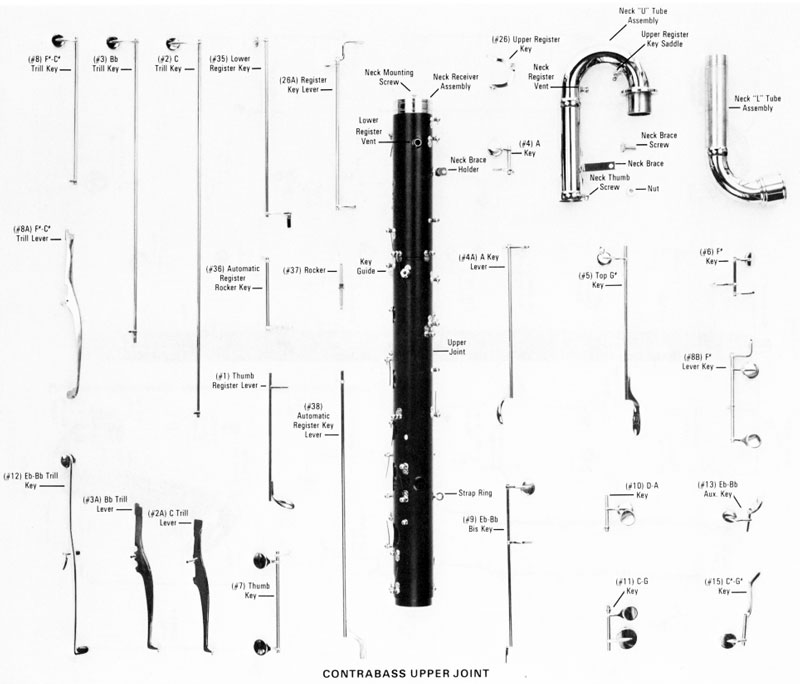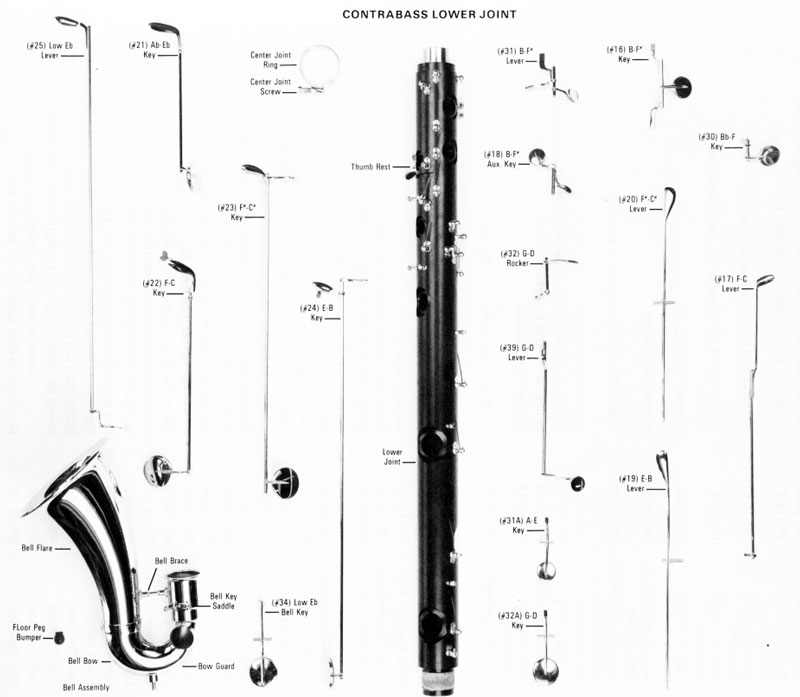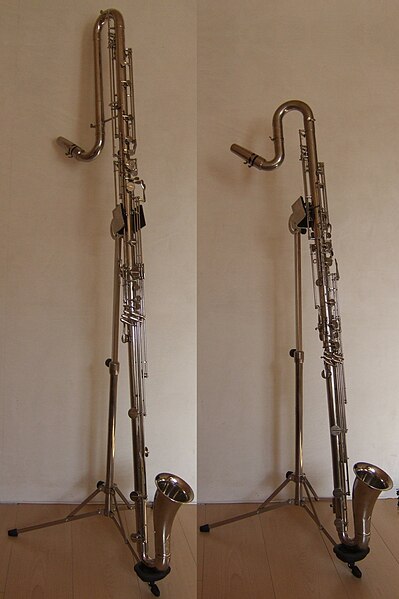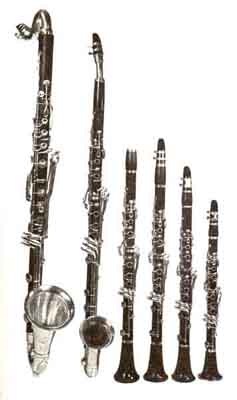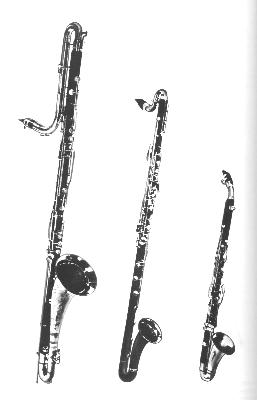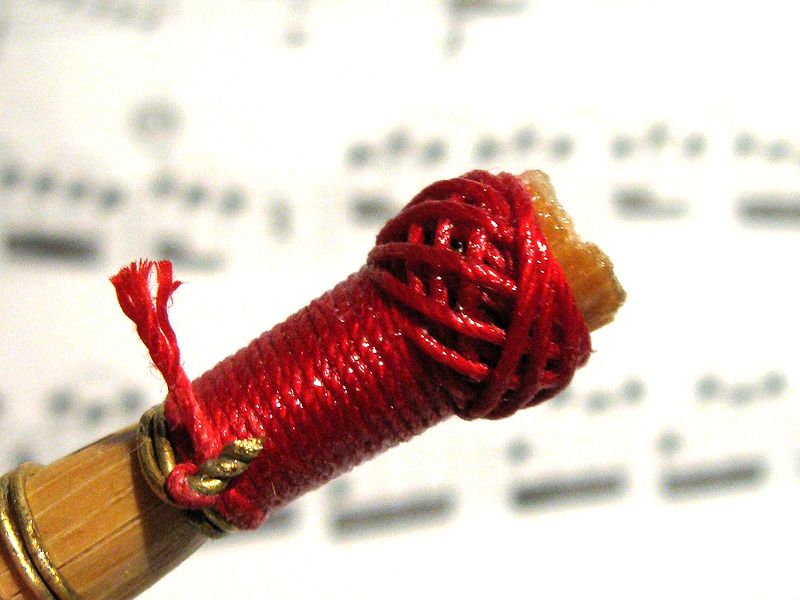I going to introduce... EVERY INSTRUMENT IN THE ORCHESTRA
The String Family
Is the largest body of the standard orchestra and consists of bowed string instruments of the violin family. It normally comprises five sections: the first violins, the second violins, the violas, the cellos, and the double basses (or basses).
Feature: 4 strings, Bowing, Tremolo, Pizzicato, With/Without Mutes
1.Violin (G D A E) (16+14)
The violin is a string instrument, usually with four strings tuned in perfect fifths. It is the smallest, highest-pitched member of the violin familyof string instruments.
Pitch range: from G3 (G below middle C) to C8 (the highest note of the modern piano.) The top notes, however, are often produced by natural or artificial harmonics. Thus the E two octaves above the open E-string may be considered a practical limit for orchestral violin parts.
2. Viola (C G D A) (12)
It is the middle voice of the violin family. Bigger than violin.
3. Cello (C G D A) (10)
The word derives from the Italian 'violoncello'. The word derives ultimately from vitula, meaning a stringed instrument. A person who plays a cello is called a cellist. The cello is used as a solo instrument, in chamber music, in a string orchestra and as a member of the string sectionof an orchestra. It is the second largest bowed string instrument in the modern symphony orchestra.
4. Double Bass (E A D G) (8)
Also called the string bass, upright bass, standup bass or contrabass, is the largest and lowest-pitched bowed string instrument in the modern symphony orchestra. A person who plays the double bass is usually referred to as a bassist.
The double bass stands around 180 cm (six feet) from scroll to endpin, and is typically constructed from several types of wood, including maple for the back, spruce for the top, and ebony for the fingerboard. It also embodies features found in the older viol family.
When playing the double bass, the bassist either stands or sits on a high stool and leans the instrument against the bassist's body with the bass turned slightly inwards in order to reach the strings more easily.
5. Harp (2)
A multi-stringed instrument which has the plane of its strings positioned perpendicularly to the soundboard.
All harps have a neck, resonator, and strings. Some, known as frame harps, also have a pillar; those lacking the pillar are referred to as open harps. Depending on its size (which varies considerably), a harp may be played while held in the lap or while it stands on a table, or on the floor. Harp strings may be made of nylon, gut, wire, or silk.
A person who plays the harp is called a harpist or harper. Folk musicians often use the term "harper", whereas classical musicians use "harpist".
Harps are roughly triangular and are usually made primarily of wood.
- The lower ends of the strings are fastened to the inside of the sounding-board.
- The body is hollow and resonates, projecting sound both toward the player through openings, and outward through the highly flexible sounding board.
- The crossbar, or neck, contains the mechanism or levers which determine the pitch alteration (sharps and flats) for each string.
- The upper ends of the strings are attached to pins in holes drilled through the neck.
- The longest side, the column, encloses the rods controlling the mechanism of a pedal harp.
- At the base are seven pedals, which activate the rods when they are downwardly pressed.
Lever harps do not have pedals or rods. Instead they use a shortening lever on the neck for each individual string which must be activated manually in order to shorten the string and raise the tone a half step. Thus, a string tuned to natural may be played in sharp, but not flat. A string tuned to flat may be played in natural, but not sharp. Lever harps are considerably lighter in weight than pedal harps and are smaller in size and number of strings.
Double chromatin harp
The Woodwind Family
A woodwind instrument is a musical instrument which produces sound when the player blows air against a sharp edge or through a reed, causing the air within its resonator (usually a column of air) to vibrate. Most of these instruments are made of wood but can be made of other materials, such as metals or plastics.
1. Piccolo (1)
The piccolo (Italian for small) is a half-size flute. The piccolo has the same fingerings as its larger sibling, the standard transverse flute, but the sound it produces is an octave higher than written. This gave rise to the name "ottavino," the name by which the instrument is referred to in the scores of Italian composers. Piccolos are manufactured in the key of C and in D♭.
Feature: Holes
2. Flute (2)
Unlike woodwind instruments with reeds, a flute is an aerophone or reedless wind instrument that produces its sound from the flow of air across an opening.
A musician who plays the flute can be referred to as a flute player, a flautist, a flutist, or less commonly a fluter.
Aside from the voice, flutes are the earliest known musical instruments. A number of flutes dating to about 40,000 to 35,000 years ago have been found in Germany.
Feature: Holes
C Flute
C Flute with vertical headjoint
G Treble Flute
Bb Tenor Flute / A Tenor Flute (cause it looks almost the same)
(a) Alto flute
It is the next extension downward of the C flute after the flûte d'amour. It is characterized by its distinct, mellow tone in the lower portion of its range. It is a transposing instrumentin G and, like the piccolo and bass flute, uses the same fingerings as the C flute.
The tube of the alto flute is considerably thicker and longer than a C flute and requires more breath from the player. This gives it a greater dynamic presence in the bottom octave and a half of its range.
Pitch range: Its range is from G3 (the G below middle C) to G6 (4 ledger lines above the treble clef staff) plus an altissimo register stretching to D♭8. The headjoint may be straight or curved.
In the classical literature, the alto flute is particularly associated with the scores of Igor Stravinsky and Maurice Ravel. It is featured in Ravel's Daphnis et Chloé, Stravinsky's The Rite of Spring.
(b) Flûte d'amour
The flûte d'amour or flauto d'amore is pitched in either A or B♭ and is intermediate in size between the modern C concert flute and the alto flute in G. It is the mezzo soprano member of the flute family. It is also sometimes called a tenor flute.
The ratio between the bore diameter and tube length is much the same as in the concert flute, which allows it to have a mellower tone colour but without losing any facility in the top octave. Its lowest sounding note is B♭ (or A).
(c) Bass flute
Is the bass member of the flute family. It is in the key of C, pitched one octave below the concert flute. Because of the length of its tube (approximately 146 cm), it is usually made with a "J" shaped head joint, which brings the embouchure hole within reach of the player.
Pitch range: from C3, one octave below middle C, to C6, two octaves above middle C. Bass flute music is written an octave higher than it sounds which is the typical concert flute range (C4 to C7). Notes written above A6 are not often used as they are difficult to produce and have inferior tone.
The shorter tube reduces acoustic resistance, which quickens the response and makes the tone brighter, livelier, and more resonant. It also makes the instrument somewhat lighter and less fatiguing for the player to hold.
Bass flutes are most often made with silver plated bodies and head joints. Kotato basses have addressed the weight problem of bass flutes by designing a graphite rod that screws onto the underside of the instrument and then rests on the chair seat between the player's legs. Adjustable rods have also been developed by Jeff Amos. Other manufacturers have added a left hand thumb support called a crutch, which helps some players with physical control of the instrument.
(d) Contra-alto flute
The contra-alto flute (also called contrabass flute in G or bass flute in F).
It is in the key of G, pitched one octave below the alto flute, and a fourth below the bass flute. It is so large that the instrument's body is held vertically, with an adjustable floor peg similar to that of the bass clarinet.
(e) Contrabass flute
Is one of the rarer members of the flute family.
Pitch range: Its range is similar to that of the regular concert flute, except that it is pitched two octaves lower; the lowest performable note is two octaves below middle C (the lowest C on the cello).
Sometimes referred to as the "gentle giant" of the flute family.
- The upper registers (middle C and above) lack the strength of tone found in its cousins;
- the strongest register is arguably that between G1 and G2;
- sensitivity and lyricism can be used to great effect;
- a good instrument can readily reach the high A or B (above middle C);
- the 'haunting' low register (below G1) has similar qualities to the bassoon;
- the low B (three octaves below middle C) can carry well with an experienced performer.
The contrabass flute requires much greater force of breath to produce sound than most other wind instruments. The addition of the contrabass flute has made to the composition of flute choirs is enormous, offering at last the grounding of a true and deep bass sound. A wider, slower air stream is needed to produce a solid tone.
(f) Double contrabass flute
Also called the octobass flute is the largest and lowest pitched metal flute in the world.
Pitch range: in the key of C, three octaves below the concert flute (two octaves below the bass flute and one octave below the contrabass flute). Its lowest note is C1, one octave below the cello's lowest C.
Despite the tendency of the larger sizes of flute to be softer than their higher pitched relatives, the double contrabass flute has a relatively powerful tone, although it usually benefits from amplification in ensembles.
A double contrabass flute constructed of PVC. The instrument is comparatively light, weighing only 7 kg , and can be produced relatively quickly and inexpensively. In addition, the PVC appears to produce a broad tone.
(g) Subcontrabass flute
Is one of the largest instruments in the flute family, measuring over 15 feet (4.6 m) long.
Pitch range: The instrument can be made in the key of G, pitched a fourth below the contrabass flute in C and two octaves below the alto flute in G; which is sometimes also called double contra-alto flute, or in C, which will sound three octaves lower than the C flute.
The subcontrabass flute is rarely used outside of flute ensembles. It is sometimes called the "gentle giant" of the flute family too. It may be made out of PVC or metal.
This instrument's unique sound quality, dark tone, and at times sluggish articulation make for excellent solo opportunities.
- C3-G3 sounds rich and it has great opportunities for dynamic power and accent.
- A3-D4 The tone becomes less secure and loses some of the lower partials and it is great for blending.
- E4-C5 has a weaker and somewhat unfocused pitch center which may be a good choice for blend or effect.
(h) Hyperbass flute
Is the largest and lowest pitched instrument in the flute family, with tubing reaching over 8 metres in length.
Pitch range: in C, four octaves below the concert flute (three octaves below the bass flute, two octaves below the contrabass flute, and one octave below the double contrabass flute), with its lowest note being C0), one octave below the lowest C on a standard piano. At 16 Hz, this is below what is generally considered the range of human hearing (20 to 20,000 Hz).
The hyperbass flute is made of PVC and wood.There appear to be wide tone holes, made from standard tee fittings, but without keys; these are covered with the palms of the hands.
The first known example of the instrument was built by Francesco Romei, a Florentine craftsman, for Italian flautist Roberto Fabbriciani. He calls it flauto iperbasso in Italian.
The instrument truly is amazing in its approach to distribution of partials, as if blown in the correct manner a three to four voice chord will sound. The instrument can produce an edgy, growling tone, as well as support a large ensemble of flutes and winds on a handful of notes (C1-F1). The 32 feet of piping, required to produce the fundamentals, permits creative exploration.
The Columbis Flute Choir
From top: Bass flute in C, alto flute in G, concert flute with B foot, concert flute with C foot (most common), soprano flute in E-flat, piccolo
3.Oboe (2)
Is a double reed musical instrument of the woodwind family. In English, prior to 1770, the instrument was called "hautbois" (French, meaning "high wood"), "hoboy", or "French hoboy". The spelling "oboe" was adopted into English ca. 1770 from the Italian oboè, a transliteration in that language's orthography of the 17th-century pronunciation of the French word hautbois, a compound word made of haut ("high, loud") and bois ("wood, woodwind"). A musician who plays the oboe is called an oboist.
Feature: Double reeds
An oboe reed
Two reeds made
A modern oboe with a reed
Comparison of various oboes. From left to right: 3-keyed Baroque oboe; 4-keyed Classical oboe; 8-keyed Early Romantic oboe; Triebert-Systeme-3-type Late Romantic oboe; "Buffet Greenline" Modern oboe.
(a) Piccolo oboe
Also known as the piccoloboe, is the smallest and highest pitched member of the oboe family, historically known as the oboe musette or terz oboe.
Pitch range: in E-flat or F above the regular oboe (which is a C instrument), the piccolo oboe is a sopranino version of the oboe, comparable to the E-flat clarinet. It can be in D, Eb or F.
(b) Oboe d'amore
The oboe d'amore (oboe of love in Italian). Slightly larger than the oboe, it has a less assertive and more tranquil and serene tone, and is considered the mezzo-soprano of the oboe family, between the oboe itself (soprano) and the cor anglais, or English horn (alto). It is a transposing instrument, sounding a minor third lower than it is notated, i.e. in A. The bell is pear-shaped and the instrument uses a bocal, similar to the larger cor anglais, whose bocal is larger.
After waning popularity in the late 18th century, the oboe d'amore fell into disuse for about 100 years until composers such as:
(i) Richard Strauss (eg. Symphonia Domestica where the instrument represents the child).
(ii) Claude Debussy (eg. in Gigues, where the oboe d'amore has a long solo passage).
(iii) Maurice Ravel (eg. Boléro where the oboe d'amore follows the E-flat clarinet to recommence the main theme for the second time around)
Baroque oboe d'amore
(c) Oboe da caccia
Literally "hunting oboe" in Italian. It pitched a fifth below the oboe and used primarily in the Baroque period of European classical music. It has a curved tube and a brass bell, unusual for an oboe.
Pitch range: close to that of the English horn, from the F below middle C (notated C4 but sounding F3) to the G above the treble staff (notated D6 but sounding G5). The oboe da caccia is thus a transposing instrument in F.
The oboe da caccia has a leather-covered wooden body terminating in a brass bell similar to a horn bell. There are typically two brass keys, E-flat and C. The E-flat key is typically repeated for the left hand. There are usually two "doubled" finger holes, G/A-flat and F/F#, similar to the soprano baroque oboe. Then the instrument is bent over steam and a slat glued onto the inside curve to fix it. The sound of it is very mellow and supple.
(d) Wiener oboe
The Akademiemodel Wiener oboe, first developed in the 1880s by Josef Hajek. The Wiener oboe is a hybrid of German and Austrian designs. It has a wider internal bore, shorter and broader reed and a different fingering schema than the Conservatoire oboe.
From the concept of the bore, the Viennese oboe is the last representative of the historical oboes, adapted for the louder, larger orchestra, and fitted with an extensive mechanism. Its great advantage is the ease of speaking, even in the lowest register. It can be played very expressively and blends well with other instruments.
The Viennese oboe is (with the Viennese horn) perhaps the most distinctive member of the Vienna Philharmonic instrumentarium.
The modern Wiener oboe is most commonly made from grenadilla, also known as African Blackwood, though some manufacturers also make oboes out of the traditional European material Boxwood.
(e) Cor anglais
The cor anglais or English horn. It is consequently approximately one and a half times the length of the oboe. The fingering and playing technique used for the cor anglais are essentially the same as those of the oboe. Music for the cor anglais is thus written a perfect fifth higher than the instrument actually sounds. Because the cor anglais normally lacks the lowest B flat of the oboe, its sounding range stretches from the E (written B natural) below middle C to the C two octaves above middle C.
Pitch range: transposing instrument pitched in F, a perfect fifth lower than the oboe (a C instrument).
Its pear-shaped bell gives it a more covered timbre than that of the oboe, being closer in tonal quality to the oboe d'amore. Whereas
- the oboe is the soprano instrument of the oboe family.
- the cor anglais is generally regarded as the alto member of the family.
- the oboe d'amore, pitched between the two in the key of A, as the mezzo-soprano member.
The cor anglais is perceived to have a more mellow and plaintive tone than the oboe. Its appearance differs from the oboe in that the reed is attached to a slightly bent metal tube called the bocal, or crook, and the bell has a bulbous shape. It is also much longer overall.
Reeds used to play the cor anglais are similar to those used for an oboe, consisting of a piece of cane folded in two. The cane part of the reed is wider and longer than that of the oboe. Cor anglais reeds typically have wire at the base, approximately 5 millimeters from the top of the string used to attach the cane to the staple. This wire serves to hold the two blades of cane together and stabilize tone and pitch.
(f) Bass oboe
The bass oboe or baritone oboe is about twice the size of a regular (soprano) oboe and sounds an octave lower; it has a deep, full tone not unlike that of its higher-pitched cousin, the English horn. The bass oboe is notated in the treble clef, sounding one octave lower than written. Its lowest note is B2 (in scientific pitch notation), one octave and a semitone below middle C, although an extension may be inserted between the lower joint and bell of the instrument in order to produce a low B-flat2. The instrument's bocal or crook first curves away from and then toward the player (unlike the bocal/crook of the English horn and oboe d'amore), and looks rather like a flattened metal question mark. Its reeds similar to but larger than that of the English horn.
(g) Heckelphone oboe
With a wider bore and hence a heavier and more penetrating tone. It is pitched an octave below the oboe and furnished with an additional semitone taking its range down to A.
The Heckelphone is approximately four feet in length, and is quite heavy: it rests on the floor, supported by a short metal peg attached to the underside of its bulbous bell. An alternate second bell, called a "muting" bell, is also available, which serves to muffle the instrument for playing in a small ensemble. This arrangement is unique among double-reed instruments. It is played with a large double reed that more closely resembles a bassoon reed than an oboe reed.
For all its potential in adding weight to the lower registers of the woodwind section, the Heckelphone remains a rarity on the orchestral scene—only about 150 Heckelphones have been produced, of which around 100 are believed to be extant—and is seldom carried on the regular roster of professional orchestras. Competent players are thus rare.
The bigger one is the Heckelphone oboe and the smaller one is the Bass oboe
(h) Piccolo Heckelphone
A very rare woodwind instrument invented in 1904 by the firm of Wilhelm Heckel in Germany. The piccolo heckelphone was intended to add power to the very highest woodwind register of the late Romantic orchestra, providing a full and rich oboe-like sound well into the sopranino range. It can be in Eb or F.
Pitch range: A transposing instrument pitched in F, a perfect fourth above the oboe, its range as described in contemporary fingering charts is from B to G♯, though it can reach tones as much as a third above this.
Following the basic principle of the heckelphone, the piccolo heckelphone in F has an extremely wide bore with large tone holes. The angle of the instrument's conicity is quite wide (though not as wide as that of a saxophone), giving it a characteristically strong and powerful tone. The instrument is built in one section with a detachable bell, and has simple-system German fingering.
(i) Contrabass oboe
The contrabass oboe is in the key of C, sounding two octaves lower than the standard oboe.
>>>>>Finally, the end of oboe.... You maybe have lot of confused of the oboe family~ Let me give it an conclusion...
From left: Oboe, Oboe d'amore, Cor Anglais.
From left: Piccolo oboe, Oboe, Oboe d'amore, Cor Anglais, Bass oboe.
From top: Heckelphone, Bass oboe, Cor Anglais, Oboe d'amore, Oboe, and Piccolo oboe.
4. Clarinet (3)
The name derives from adding the suffix -et (meaning little) to the Italian word clarino(meaning a type of trumpet), as the first clarinets had a strident tone similar to that of a trumpet. The instrument has an approximately cylindrical bore.
Feature: a single reed
Clarinets comprise a family of instruments of differing sizes and pitches. The word clarinet usually refers to the B♭ soprano clarinet, by far the most commonly played clarinet.
A person who plays the clarinet is called a clarinetist or clarinettist. The clarinet family is keyed in Bb and Eb.
Clarinet bodies have been made from a variety of materials including wood, plastic, hard rubber, metal, resin, and ivory.
- The vast majority of clarinets used by professional musicians are made from African hardwood. Historically other woods, notably boxwood, were used.
- Most modern, inexpensive instruments are made of plastic resin (resonite), which is Selmer's trademark name for its type of plastic. Ivory was used for a few 18th century clarinets, but it tends to crack and does not keep its shape well.
- Buffet Crampon's Greenline clarinets are made from a composite of grenadilla wood powder and carbon fiber and are less affected by humidity and temperature changes than wooden instruments but are heavier.
- Alastair Hanson and Tom Ridenour are strong advocates of hard rubber. Hard rubber, such as ebonite, has been used for clarinets since the 1860s.
- Hanson Clarinets of England manufactures clarinets using a grenadilla compound reinforced with ebonite, known as 'BTR' (bithermal reinforced) grenadilla. This material is also not affected by humidity, and the weight is the same as that of a wood clarinet.
- Mouthpieces are generally made of hard rubber, although some inexpensive mouthpieces may be made of plastic. Other materials such as crystal/glass, wood, ivory, and metal have also been used.
- Ligatures are often made out of metal and plated in nickel, silver or gold. Other ligature materials include wire, wire mesh, plastic, naugahyde, string, or leather.
- Reed made from the cane of Arundo donax, a type of grass. Reeds may also be manufactured from synthetic materials. The ligature fastens the reed to the mouthpiece. When air is blown through the opening between the reed and the mouthpiece facing, the reed vibrates and produces the instrument's sound.
- Basic reed measurements are as follows: tip, 12 mm (0.47 in) wide; lay, 15 mm (0.59 in) long (distance from the place where the reed touches the mouthpiece to the tip); gap, 1 mm (0.039 in) (distance between the underside of the reed tip and the mouthpiece). Adjustment to these measurements is one method of affecting tone color. Reed and mouthpiece characteristics work together to determine ease of playability, pitch stability, and tonal characteristics.
Clarinet reed, mouthpiece, and ligature
Clarinet barrel
Clarinet upper joint
Clarinet lower joint
Clarinet bell
Clarinet in four view
(a) Piccolo clarinet ~A♭, E♭, D
The smaller and higher pitched than the more familiar high soprano clarinets in E♭ and D. Shackleton also lists obsolete instruments in C, B♭, and A♮.
Some writers call these sopranino clarinets or octave clarinets. The boundary between the piccolo and soprano clarinets is not well-defined, and the rare instruments in G and F might be considered as either. Shackleton along with many early twentieth-century composers uses the term "piccolo clarinet" to refer to the E♭ and D clarinets as well. This designation is now less common today; with the E♭ and D instruments are more usually designated soprano clarinets.
Pitch range: The A♭ clarinet is pitched a minor seventh higher than the B♭ soprano clarinet. Its lowest note, E, sounds as concert middle-C, the same as many concert flutes.
Size comparison among the A♭, E♭, and B♭ clarinets
Size comparison of the B♭, E♭, and A♭ reeds
(b) Soprano clarinet ~C, B♭, A
The sub-family of the clarinet family. They include the most common types of clarinets, and indeed are often referred to as simply "clarinets". Among the soprano clarinets are the B♭ clarinet. Sopranino clarinets for the E♭ and D clarinets, these are more usually regarded as soprano clarinets as well.
Pitch range:
- From D below middle C (written E) to about the C three octaves above middle C;
- The A and C clarinets, sounding respectively a semitone lower and a whole tone higher than the B♭ clarinet;
- Gb clarinet, sounding yet a whole tone lower than the A, rare in western music but popular in the folk music of Turkey.
The clarinet family is commonly used in an orchestral setting to provide color, especially with regards to harmonies. Composers in the classical and romantic periods featured clarinet solos as well, relying on its unique tone and range.
Clarinets in C are common in music of the classical period and in some later music, particularly opera. There have also been soprano clarinets in C, A, and B♭ with curved barrels and bells marketed under the names Saxonette, Claribel, and Clariphon.
Shackleton lists also obsolete "sopranino" clarinets in (high) G, F, and E, and soprano clarinets in B and A♭. The G "sopranino", only a half step lower than the A♭ piccolo clarinet, was popular during the Biedermeier period in Vienna for playing Schrammelmusik.
C soprano clarinet
Bb soprano clarinet
Eb soprano clarinet
A soprano clarinets
(c) Eb clarinet
It is usually classed as a soprano clarinet, although some authors describe it as a "sopranino" or even "piccolo" clarinet. Smaller in size and higher in pitch than the more common B♭ clarinet, it is a transposing instrument in E♭, sounding a minor third higher than written. In Italian it sometimes referred to as a quartino, generally appearing in scores as quartino in Mi♭.
The E♭ clarinet is used in orchestras, concert bands, marching bands, and clarinet choirs carrying the high melodies that would be treacherous for the B♭ clarinet. Solo repertoire is limited.
The E♭ clarinet is required to play at the top of its range for much of the time to take advantage of its piercing quality. Fingerings in that register are more awkward than on the lower part of the instrument, making high, fast passages difficult.
(d) Basset clarinet
Similar to the usual soprano clarinet but longer and with additional keys to enable playing several additional lower notes. Typically a basset clarinet has keywork going to a low (written) C, as opposed to the standard clarinet's E or E♭ (both written), and is most commonly a transposing instrument in A, although basset clarinets in C and B♭ also exist. The similarly named basset horn is also a clarinet with extended lower range, but is in a lower pitch (typically F); the basset horn predates, and undoubtedly inspired, the basset clarinet.
Mozart wrote his Clarinet Quintet in A major, K. 581 and Clarinet Concerto in A Major, K622 for this instrument; the concerto is partly based on an earlier fragment of a Concerto for Basset Horn in G, K584b.
An A-clarinet with an extension of a terts down. It is in fact related to the basset horn in F of G.
(e) Basset horn
Larger and has a bend near the mouthpiece rather than an entirely straight body (older instruments are typically curved or bent in the middle), and while the clarinet is typically a transposing instrument in B♭ or A (meaning a written C sounds as a B♭ or A), the basset horn is typically in F (less often in G).
The basset horn has additional keys for an extended range down to written C, which sounds F at the bottom of the bass staff. Its timbre is similar to the clarinet's, but darker and less brilliant. Basset horns in A, G, E, E♭, and D also were made; the first of these is closely related to the basset clarinet.
The basset horn is not a horn; its name probably derives from the resemblance of early, curved or angled versions to a horn.
Modern basset horns can be divided into three basic types, distinguished primarily by bore size and, consequently, the mouthpieces with which they are played:
- The small-bore basset horn has a bore diameter in the range of 15.5 to 16.0 mm (still somewhat larger than a soprano clarinet bore, though it is often erroneously thought to be the same; even a large bore English clarinet, such as the old B&H 1010 design has a smaller bore of 15.3 mm). It is played with a B♭/A clarinet mouthpiece. Only Selmer (Paris) and Stephen Fox (Canada) currently make this model.
- The medium-bore basset horn has a bore diameter in the region of 17.0 mm or slightly less.
- The large-bore basset horn, with a bore diameter of about 18.0 mm and played with an alto-clarinet mouthpiece, is in constructional terms an alto clarinet pitched in F and with the extra basset notes. The Leblanc basset horns (bores c. 18.0 to 18.2 mm) are of this type
- The current Buffet basset horn could be called a hybrid "medium-large bore" model, since it uses an alto-clarinet mouthpiece but has a bore diameter around 17.2 mm.
F basset clarinet
(f) Alto clarinet
It is a transposing instrument pitched in the key of E♭, though instruments in F (and in the 19th century, E) have been made. It is sometimes known as a tenor clarinet; this name especially is applied to the instrument in F.
In size it lies between the soprano clarinet and the bass clarinet, to which it bears a greater resemblance in that it typically has a straight body (made of Grenadilla or other wood, hard rubber, or plastic), but a curved neck and bell made of metal. All-metal alto clarinets also exist.
In appearance it strongly resembles the basset horn, but usually differs in three respects:
- pitched a tone lower
- lacks an extended lower range
- a wider bore than most basset horns
Pitch range: from the concert G or G♭ in the second octave below middle C to the middle of the second octave above middle C.
Modern alto clarinets have the Boehm system or Oehler system of keys and fingering, which means that this clarinet has virtually identical fingering to the others. However the alto clarinet usually has an extra key allowing it to play a low (written) E♭, and a key pad played by the left-hand index finger with a vent that may be uncovered to assist in playing the altissimo register.
the parts
(g) Bass clarinet
Like the more common soprano B♭ clarinet, it is usually pitched in B♭(meaning it is a transposing instrument on which a written C sounds as B♭), but it plays notes an octave below the soprano B♭ clarinet. Bass clarinets in other keys, notably C and A, also exist.
Bass clarinets regularly perform in symphony orchestras, wind ensembles, occasionally in marching bands, and play an occasional solo role in contemporary music and jazz in particular.
Most modern bass clarinets are straight-bodied, with a small upturned silver-colored metal bell and a curved metal neck. Early examples varied in shape, some having a doubled body making them look similar to bassoons.
The bass clarinet is fairly heavy and is supported either with a neck strap or with an adjustable peg attached to its body.
Bass clarinet bodies are most often made of grenadilla or African Blackwood, or (more commonly for student instruments) plastic resin or all-metal(but are rare).
In differences keywork, many professional and advanced bass clarinetists own instruments with extensions down to a C (sounding B♭, identical to the bassoon's lowest B♭, and a whole step below the cello's lowest C) a full octave below written middle C.
At concert pitch this note is the B♭ below the second ledger line below the bass staff, or B♭1 in scientific pitch notation. Overall, the instrument sounds an octave lower than the B♭ soprano clarinet.
(h) Contra-alto clarinet
The contra-alto clarinet is a large, low-sounding musical instrument of the clarinet family.
The modern contra-alto clarinet is pitched in the key of EEb
"Contra-alto" is meant to convey, by analogy with "contrabass", that the instrument plays an octave lower than the alto clarinet. It is the second-largest member of the clarinet family in significant use, larger than the bass clarinet but not as big as the BBb contrabass clarinet.
The keys of the contra-alto are similar to the keys on smaller clarinets, and are played in the same way. Some contra-alto clarinet models have a range extending down to low (written) Eb, sounding as the lowest Gb on the piano (aka Gb1), while others can play down to low C.
The earliest contra-alto clarinets were developed in the first half of the nineteenth century.
The contra-alto clarinet is used mostly in concert bands and clarinet choirs. It is occasionally used in jazz and can also be used in marching bands where it shares the parts of the sousaphone or baritone saxophone. However, because of its size and weight, many bands choose not to march them in parades.
(i) Contrabass clarinet
The largest member of the clarinet family that has ever been in regular production or significant use. The contrabass clarinet is also sometimes known by the name pedal clarinet.
- Modern contrabass clarinets are pitched in BB♭, sounding two octaves lower than the common B♭ soprano clarinet and one octave lower than the B♭ bass clarinet.
- Some contrabass clarinet models have a range extending down to low (written) E♭, while others can play down to low D or further to low C.
- Some early instruments were pitched in C.
The EE♭ contra-alto clarinet is sometimes referred to as the "EE♭ contrabass clarinet".
Contrabass clarinet upper parts
Contrabass clarinet lower parts
Contra-alto clarinet (right) compared to a contrabass clarinet (left).
From Left: Bb Contrabass clarinet, Contra-alto clarinet, Bb Bass clarinet, Alto clarinet, Bb clarinet.
(j) Subcontrabass clarinet
- The octocontra-alto clarinet (also known as octo contra alto, sub contra alto, or octocontralto) is the second largest member of the clarinet family. The instrument is pitched one octave lower than the E♭ contra-alto clarinet, two octaves lower than the E♭ alto clarinet, and two octaves and a fifth lower than the standard B♭ soprano clarinet (making it an EE♭ transposing instrument). Only three octocontra-alto clarinets were ever built, all by the G. Leblanc Corporation.
- The octocontrabass clarinet (also known as octo contrabass clarinet, octo contra bass clarinet, or subcontra bass clarinet) is the largest and lowest member of the clarinet family. It is pitched an octave below the contrabass clarinet, or three octaves lower than the standard B♭ soprano clarinet. It stood at near 8 foot 2 inches (2.49 m).
- Only one such instrument was ever produced, by Leblanc. At least three pieces of music have been written specifically for it by: Norwegian composer Terje Lerstad (Trisonata, Op. 28; De Profundis, Op. 139; and Mirrors in Ebony for clarinet choir, Op. 134). Two more by American composer Adam Gilberti ("Reflections of Honor", for large orchestra, "Four Poems" for orchestra and mixed chorus).
Haha~ i know u very very confused!! Let me do some conclusion~~~
Bb bass clarinet, basset horn, A clarinet, Bb clarinet, C clarinet, Eb clarinet
BBb contrabass clarinet, Bb bass clarinet (with low C extension), Eb alto clarinet
From smallest to largest: Eb sopranino, Bb soprano, Eb alto, Bb bass, Eb contra-bass, Bb subcontra bass.
Now... the whole family!!!
From left:
Eb sopranino,
Eb octocontraalto to low C,
Bb bass to low Eb,
Bb soprano,
Bb octocontrabass to low C,
A soprano,
Bb contrabass to low C,
Ab piccolo,
Eb alto,
F bassett horn to low C,
Bb bass to low C,
C soprano,
D sopranino,
Eb contraalto to low C
5. (a) Bassoon (2)
Appearing in its modern form in the 19th century, the bassoon figures prominently in orchestral, concert band and chamber music literature. The bassoon is a non-transposing instrument known for its distinctive tone color, wide range, variety of character and agility. Listeners often compare its warm, dark, reedy timbre to that of a male baritone voice.
Its made in two system, either Heckel (German) system or Buffet (French) system.
Feature: double reed. Bassoons are double reed instruments like the oboe and the English horn.
The bassoon disassembles into six main pieces, including the reed.
- The bell (6), extending upward;
- the bass joint (or long joint) (5), connecting the bell and the boot;
- the boot (or butt) (4), at the bottom of the instrument and folding over on itself;
- the wing joint (3), which extends from boot to bocal;
- the bocal (or crook) (2), a crooked metal tube that attaches the wing joint to a reed (1)
The modern bassoon is made of maple, or plastic for beginners, with medium-hardness types such as sycamore maple and sugar maple preferred. Less-expensive models are also made of materials such as polypropylene and ebonite, primarily for student and outdoor use; metal bassoons were also made in the past.
- The bore of the bassoon is conical, and the two adjoining bores of the boot joint are connected at the bottom of the instrument with a U-shaped metal connector. Both bore and tone holes are precision-machined, and each instrument is finished by hand for proper tuning.
- Wooden instruments are lined with hard rubber along the interior of the wing and boot joints to prevent damage from moisture; wooden instruments are also stained and varnished.
- The end of the bell is usually fitted with a ring, either of metal, plastic or ivory. The joints between sections consist of a tenon fitting into a socket; the tenons are wrapped in either cork or string as a seal against air leaks.
- The bocal connects the reed to the rest of the instrument and is inserted into a socket at the top of the wing joint. Bocals come in many different lengths and styles, depending on the desired tuning and playing characteristics.
- The walls of the bassoon are thicker at various points along the bore; here, the tone holes are drilled at an angle to the axis of the bore, which reduces the distance between the holes on the exterior. This ensures coverage by the fingers of the average adult hand.
The bassoon stands 1.34 m (4.4 feet) tall, but the total sounding length is 2.54 m (roughly 8.3 feet). Playing is facilitated by doubling the tube back on itself and by closing the distance between the widely spaced holes with a complex system of key work, which extends throughout nearly the entire length of the instrument.
Pitch range: begins at B-flat1 (the first one below the bass staff) and extends upward over three octaves (roughly to the G above the treble staff). Higher notes are possible but difficult to produce and rarely called for; orchestral parts rarely go higher than the C or D.
The reeds
Bassoon reed binding
The Bassoon
(b) Contrabassoon (1)
Also known as the double bassoon or double-bassoon, sounding an octave lower(bassoon). Its technique is similar to its smaller cousin, with a few notable differences.
The reed is considerably larger, at 65–75 mm in total length as compared to 53–58 mm for most bassoon reeds. The contrabassoon reed is 20mm wide.
The instrument is twice as long, curves around on itself twice, and, due to its weight and shape, is supported by an endpin rather than a seat strap. Additional support is sometimes given by a strap around the player's neck.
A wider hand position is also required, as the primary finger keys are widely spaced.Fingering is slightly different, particularly at the register change and in the extreme high range.
Pitch range: beginning at B♭0 (extending down a half-step to the lowest note on the piano on instruments with the low A extension or to A♭in one example), and extending up just over three octaves, the contrabassoon is the deepest available sound and provides a solid underpinning to the orchestra.
The instrument has a high range extending to middle C, but the top fifth is rarely used. While prominent in solo and small ensemble situations, the sound can be completely obscured in the volume of the full orchestra.
It is also often used to support other mixed orchestrations, such as doubling the bass trombone or tuba at the octave.
The reed
The Contrabassoon
(c) Tenoroon
Also called tenor bassoon. Smaller version of the tenor bassoon, the octave bassoon. Tenoroons are extremely rare in the United States.
Instruments pitched an octave above the bassoon are, like all smaller bassoons, historically quite old instruments.
haha~~ that all for woodwind~~
opps.. saxophone too woodwind >.<
haizz.. to bo continue in Part 2 of 2 : D
by . heidi <3






